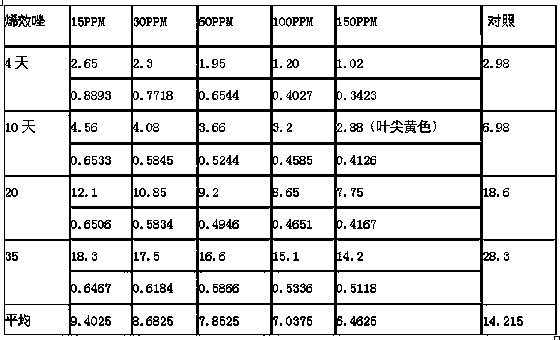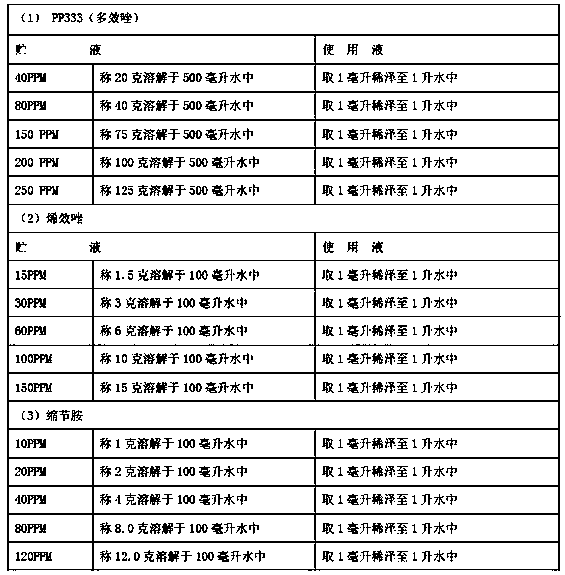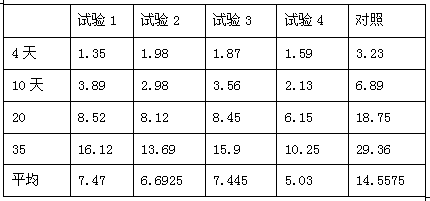Aquatic canna dwarfing method
A canna, aquatic technology, applied in the agricultural field, can solve problems such as the inability to produce beautiful products
- Summary
- Abstract
- Description
- Claims
- Application Information
AI Technical Summary
Problems solved by technology
Method used
Image
Examples
Embodiment 1
[0018] Example 1: Selection of dwarfing agent concentration
[0019] 1) Concentration and preparation of dwarfing agent: The prepared concentration is divided into storage solution and use solution. The storage solution can be stored in a cool place for three months, and the use solution is ready to use.
[0020] The concentration and preparation method of dwarfing agent are shown in Table 1:
[0021]
[0022] 2) Dwarfing treatment method
[0023] ① Pot experiment
[0024] There are four series of paclobutrazol, meclobutan, uniconazole and the control. According to the concentration in the above table, two methods of spraying and root soaking are used respectively, a total of 80 groups, each with ten pots of seedlings.
[0025] Planting seedlings per pot: Canna canna seedlings are 4 buds per pot.
[0026] Requirements for seedlings: The seedlings used for the test must be robust, disease-free, and the plant height and stem thickness should be the same among the pots.
[0027] Requirements ...
Embodiment 2
[0044] Example 2: Selection of dwarfing agent combination
[0045] Use single dwarfing agent and combined dwarfing agent for root soaking treatment
[0046] Test 1: 150 ppm paclobutrazol aqueous solution soaked the roots for 12 hours;
[0047] Test 2: Root immersion in 80 ppm aqueous solution of meepamine for 12 hours;
[0048] Test 3: Soaking the roots with 60ppm Uniconazole aqueous solution for 12 hours;
[0049] Test 4: First soak the roots with 150ppm Paclobutrazol aqueous solution for 4 hours and dry in the shade for 4 hours; then soak the roots with 80ppm aqueous solution of Meconazole for 4 hours and dry for 4 hours in the shade; then use 60ppm Uniconazole aqueous solution to soak the roots for 4 hours and dry for 4 hours in the shade. hour;
[0050] Control: clean water treatment.
[0051] Table 5: The dwarfing effect starts on March 5 (with the newly increased height of the leaves)
[0052]
[0053] It can be seen from Table 5 that the use of combined dwarfing agent for root soak...
Embodiment 3
[0054] Example 3: Selection of dwarfing agent combination
[0055] Use a single dwarfing agent and a combination of dwarfing agents to spray treatment until the leaves are wet.
[0056] Test 1: 150 ppm paclobutrazol aqueous solution was sprayed;
[0057] Test 2: Spray treatment with 80 ppm of membranous amine solution;
[0058] Test 3: 60ppm Uniconazole aqueous solution was sprayed;
[0059] Test 4: First spray with 150ppm paclobutrazol aqueous solution; 3 days after the first spray, 80ppm aqueous solution of mecone was used for the second spray; 3 days after the second spray, 60ppm The third spray of the solution of Uniconazole;
[0060] Control: clean water treatment.
[0061] Table 6: The dwarfing effect starts on March 5th (with the newly increased height of the leaves)
[0062]
[0063] It can be seen from Table 6 that using combined dwarfing agents for spray treatment can significantly improve the dwarfing effect.
PUM
 Login to View More
Login to View More Abstract
Description
Claims
Application Information
 Login to View More
Login to View More - R&D
- Intellectual Property
- Life Sciences
- Materials
- Tech Scout
- Unparalleled Data Quality
- Higher Quality Content
- 60% Fewer Hallucinations
Browse by: Latest US Patents, China's latest patents, Technical Efficacy Thesaurus, Application Domain, Technology Topic, Popular Technical Reports.
© 2025 PatSnap. All rights reserved.Legal|Privacy policy|Modern Slavery Act Transparency Statement|Sitemap|About US| Contact US: help@patsnap.com



